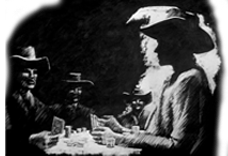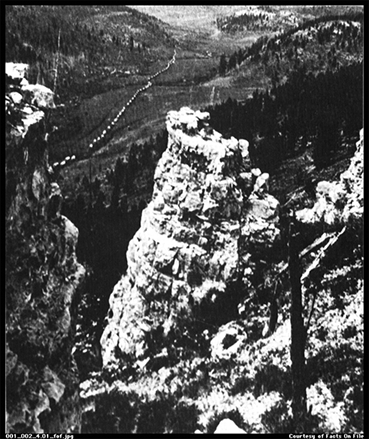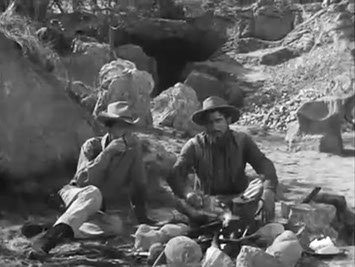





Black Hills
Mountain range, mostly in the western Dakota Territory but spilling into the eastern Wyoming Territory. Considered sacred land by the Sioux.[1]
Fur trappers and a few prospective miners often explored the Black Hills, but with the 1868 Treaty of Fort Laramie, the Black Hills became part of the Great Sioux Reservation and white men were forbidden to enter the region. However, many continued to usurp the rich resources of the Black Hills, taking their chances with the hostile Sioux.[1]
In 1874, Lieutenant Colonel George Armstrong Custer's Black Hills Expedition discovered gold within the Black Hills. When word of Custer's gold strike got out in 1875, hundreds of gold fever-struck prospectors began invading the Black Hills. The Army tried keep the trespassers off the Indian land, but the hostile Sioux were keeping them stretched thin.[1]
Stage West: In June of 1875,[3] Sam Harris discovered a pocket free gold near Stoney Gap along the far northeast edge of the Black Hills. He took a nugget from the strike to the assay office in Twin Bluffs that ran ninety percent gold. Word of the high-grade nugget traveled quickly around the region. Knowing mining the claim would be extremely difficult for one man, Harris hired a partner, Matson, to help him work his claim. He and Matson set out for the Black Hills together, but Mart Fallon and his sons Wes and Rip had heard of the rich strike and wanted it for themselves. They tracked Harris and Matson into the Black Hills but after a few days, Harris discovered their trail and began leading them in circles, away from the claim.[4]
After a week[3] of tracking the two miners, the Fallons confronted them, trying to force them to lead them to the mine and cut them in for a share. Harris refused and was mortally shot by Wes Fallon. When the Fallons pressed Matson to take them to the mine, Matson had to admit he didn't know where it was, but knew of someone coming in to the Packsaddle Station[4] in Nebraska[3] to meet Harris who would know. The Fallons took Matson out of the Black Hills to the stage station.[4] The next day,[3] Bret Maverick happened to come across Harris as he was dying, not far from the claim. Bret tried to remove Wes Fallon's bullet, but failed. Harris was grateful and took Bret to the mine. Knowing he was dying, he gave Bret the gold nuggets he had unearthed to take to his wife, Linda, who was to arrive at the Packsaddle Station[4] the following week.[3]
Bret realized the strike Harris had made was only a pocket of free gold and was played out, worth nothing more than the nuggets he had already mined. Harris died[4] two days later[3] and Bret buried him at the site of the claim. Two hours after Bret left the Harris Mine, a party of Sioux warriors discovered him removing gold from their land. They chased him out of the Black Hills and across the Dakota prairies until Bret was able to lose them near[4] the Nebraska border.[3]
By 1876, the stampede of gold seekers so overran the Black Hills that the Army could no longer effectively enforce the Treaty of Fort Laramie. Overly occupied with fighting the Sioux Wars, they allowed the miners and other opportunists to trespass into the Black Hills and surrounding country, letting them fend for themselves. Early that year, rich gold strikes in the northern Black Hills led to the establishment of such boom towns as Deadwood and Lead.
The natural resources of the region became so attractive to the economy that the U. S. government reconsidered it's agreement with the Sioux and revoked the Treaty of Fort Laramie with the Act of February 28, 1877 which took the rights to the Black Hills away from them.[1]
Stampede: In March of 1877,[3] Noah Perkins came to the Black Hills from Council Bluffs to settle[5] in Boulder Canyon[3] along the trail into Deadwood.[5] In April,[3] Perkins was paid $1,000 for helping Bret Maverick win a boxing match against Battling Kreuger. Together with additional funds from his fiancée, Madame Pompey, Perkins was able to buy the valley and protect it's wildlife from other encroaching settlers.[5]
SOURCE REFERENCES
01. The Lakotas and the Black Hills: The Struggle for Sacred Ground; Jeffrey Ostler, — Viking Adult, July 22, 2010
02. Indians of North America — The Native American Experience: 1875 – 1890; California State University, Long Beach (retrieved January 2, 2015)
03. The Conjectural Maverick, Maverick Trails
04. Maverick, Stage West (1957), Warner Bros. Pictures, Inc.
05. Maverick, Stampede (1957), Warner Bros. Pictures, Inc.
Lieutenant Colonel George Armstrong Custer's wagon train arrives in the Black Hills, 1874.[2]
Matson and Sam Harris camp out in the Black Hills, 1875.[4]
Bret Maverick and Dandy Jim Buckley ride through the Black Hills on the trail to Deadwood, 1877.[4]



Home | The Maverick Saga | Trail Maps | Chronology | Maverick Lore | Production | The Inside Straight | Contact Maverick Trails
Maverick Trails is not endorsed, sponsored or affiliated with Warner Bros. Entertainment, Inc. or the Maverick franchise.
Maverick™ and its various marks are trademarks of Warner Bros. Entertainment, Inc., © 1957, 1994
©2014, 2015, 2016 Maverick Trails

